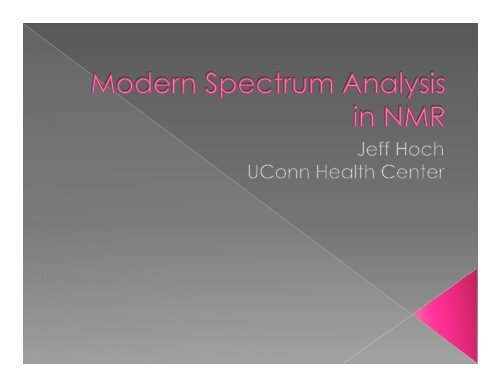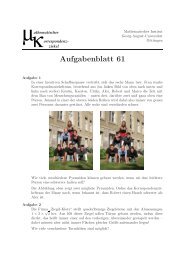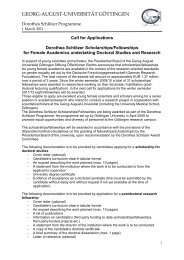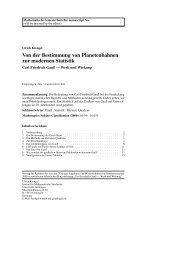Modern Spectrum Analysis in NMR
Modern Spectrum Analysis in NMR
Modern Spectrum Analysis in NMR
You also want an ePaper? Increase the reach of your titles
YUMPU automatically turns print PDFs into web optimized ePapers that Google loves.
Only method capable of determ<strong>in</strong><strong>in</strong>g the structure<br />
of biological macromolecules <strong>in</strong> solution at atomic<br />
resolution<br />
Uniquely able to probe dynamics<br />
Useful for <strong>in</strong>vestigat<strong>in</strong>g biomolecular <strong>in</strong>teractions<br />
(aff<strong>in</strong>ities and strucctures)<br />
Useful for <strong>in</strong>vestigat<strong>in</strong>g biomolecular rate processes<br />
(e.g. prote<strong>in</strong> fold<strong>in</strong>g, enzyme k<strong>in</strong>etics)<br />
Important applications <strong>in</strong> drug discovery,<br />
metabolomics
Very few mathematical tools have had the<br />
impact of the Fourier Transform on science<br />
and eng<strong>in</strong>eer<strong>in</strong>g<br />
Jean Baptiste Joseph Fourier (1768 – 1830)
Fourier Transform <strong>NMR</strong><br />
Impulse<br />
FT<br />
Ernst & Anderson, 1963<br />
SW = 1/ Δt<br />
Δt
• Exactly <strong>in</strong>vertible: iDFT <br />
• L<strong>in</strong>ear: DFT(A+B) = DFT(A) + DFT(B)<br />
implies S/N ∝<br />
N<br />
• Assumes signal is periodic (period = NΔt)<br />
• Efficient algorithms: FFT (~NlogN operations)<br />
(Cooley & Tukey, 1965)
Jean Jeener, 1971<br />
Parametric sampl<strong>in</strong>g<br />
of <strong>in</strong>direct time dimensions<br />
Δt 1<br />
Δt 2
• High resolution requires sampl<strong>in</strong>g at long<br />
times<br />
• Short times for high sensitivity<br />
• DFT requires uniformly spaced samples
Super-resolution<br />
Higher sensitivity<br />
Shorter experiments
• “Matched filter” for sensitivity<br />
enhancement (van Vleck et al; Ernst<br />
<strong>in</strong>troduced to <strong>NMR</strong>)<br />
• Emphasis on long times for resolution<br />
enhancement (s<strong>in</strong>e-bell, Lorentzian-to-<br />
Gaussian, etc.)
LP extrapolation reduces truncation<br />
artifacts, but <strong>in</strong>troduces errors<br />
(false peaks, frequency shifts)
<strong>Modern</strong> spectrum analysis <strong>in</strong> <strong>NMR</strong>,<br />
an <strong>in</strong>complete time l<strong>in</strong>e<br />
1983<br />
LP extrapolation Ni & Scheraga (1983)<br />
MaxEnt reconstruction Sibisi et al. (1983,1984)<br />
Burg MEM Mart<strong>in</strong>; Hoch (1985)<br />
LPSVD van Ormondt et al. (1985)<br />
Exponential sampl<strong>in</strong>g Laue, Skill<strong>in</strong>g et al. (1987)<br />
Iterative threshold<strong>in</strong>g (Jansson-Van Cittert) Scheraga et al. (1989)<br />
Complex entropy Hore et al., Hoch et al. (1990)<br />
Bayesian, MLM Bretthorst; Chylla & Markley (1990; 1993)<br />
GFT Szyperski et al. (1993)<br />
Wavelet transform, iterative soft thresh Hoch & Stern (1996)<br />
Filter diagonalization Mandelshtam, Shaka et al. (2000)<br />
Multiway decomposition Billeter, Orekhov et al. (2001)<br />
Back projection Kupče & Freeman 2002<br />
Covariance <strong>NMR</strong> Brüschweiler et al. (2004)<br />
“Multidimensional FT” Kozm<strong>in</strong>ski et al., 2006<br />
Now Compressed sens<strong>in</strong>g Donoho et al. (“2004”)
Classify<strong>in</strong>g methods<br />
periodicity<br />
random noise<br />
Robustness<br />
symmetry<br />
exponential<br />
decay<br />
model<br />
Assumptions
LP, LPSVD, HSVD, Burg maximum entropy<br />
d j<br />
=<br />
K<br />
∑<br />
i =1<br />
a i<br />
d j −i<br />
Bayesian, MLM, FDM<br />
€ d k<br />
=<br />
L<br />
∑<br />
j =1<br />
a j<br />
e iφ j<br />
e −kΔt / τ j<br />
e 2πikΔtω j<br />
+ ε k<br />
Be<strong>in</strong>g parametric, they yield frequency lists directly<br />
Prone to bias, false positives when S/N is low or signals non-ideal
S i<br />
(f 1<br />
,f 2<br />
,f 3<br />
) = s i<br />
(f 1<br />
) ⊗ s i<br />
(f 2<br />
) ⊗ s i<br />
(f 3<br />
)<br />
Also known as PARAFAC; PCA is a 2D equivalent<br />
€<br />
Billeter, Orekhov et al.<br />
(Denk & Wagner;<br />
R<strong>in</strong>aldi et al.)<br />
Less restrictive than the exponential decay assumption<br />
Random noise does not have a decomposition<br />
Unique decomposition restricted to 3+ dimensions
Brüschweiler et al. (2004)<br />
Frequency correlations <strong>in</strong> nD via covariance rather than spectrum<br />
analysis<br />
C is the correlation matrix, F is the 2DFT or the f 2 -t 1 <strong>in</strong>terferogram<br />
Affords the resolution of the direct (f 2 ) dimension <strong>in</strong> the <strong>in</strong>direct<br />
dimension<br />
€<br />
C = (FF T )<br />
Scal<strong>in</strong>g the <strong>in</strong>tensities appropriately requires matrix square root; can<br />
use SVD<br />
Extensions to <strong>in</strong>direct correlations enable application to<br />
unsymmetrical spectra
Back projection, by analogy to CT<br />
Kupče & Freeman 2002<br />
t 2<br />
f 2<br />
t 1<br />
f 1<br />
Radial sampl<strong>in</strong>g <strong>in</strong> the time doma<strong>in</strong> yields tilted projections <strong>in</strong> frequency
Data d Trial spectrum f Mock data ˆ (= iDFT(f))<br />
Maximize<br />
N<br />
S(f) = ! " f k logf k<br />
k = 1<br />
S=(entropy, l 1 -norm, l 2 -norm, etc.)<br />
Subject to<br />
C(f,d) =<br />
M<br />
" ( d j ! ˆ ) 2 #≈ noise<br />
j=1<br />
d j<br />
Fixed-po<strong>in</strong>t, convex optimization, <strong>in</strong>terior po<strong>in</strong>t
Entropy functionals for <strong>NMR</strong><br />
Shannon entropy <strong>in</strong>appropriate for spectra with +/- components,<br />
or complex (phase-sensitive)<br />
Entropy of the power spectrum has multiple critical po<strong>in</strong>ts, thus no<br />
unique solution; other problems<br />
Skill<strong>in</strong>g et al.: 2-channel entropy (f = f + - f - ; S = S + + S - )<br />
4-channel for complex spectra; computational cost<br />
due to additional unknowns; entropy depends on phase<br />
Entropy for an ensemble of sp<strong>in</strong>-1/2 particles (Hore et al.; Hoch,<br />
Donoho et al.) is <strong>in</strong>sensitive to phase, convex
Logan’s Theorem<br />
perfect reconstruction is possible from <strong>in</strong>complete and noisy<br />
data by maximiz<strong>in</strong>g the l 1 -norm under certa<strong>in</strong> conditions<br />
Noisy debates still erupt<br />
see Times of London, J. Roy. Stat. Soc.<br />
John Skill<strong>in</strong>g:<br />
“If you just want a nice picture for the brochure, or to keep your<br />
sponsor happy, maximise a nice functional like entropy (or 1-norm).<br />
If you want to be properly professional and take uncerta<strong>in</strong>ty and<br />
error bars seriously, then you need an id prior, and those posteriors<br />
are a lot harder to compute.”
When N = M, Parseval’s Theorem<br />
MaxEnt: analytic solution<br />
Donoho, Johnstone, Stern, and Hoch PNAS 87, 5066-5068 (1990)<br />
<strong>in</strong> essence allow<strong>in</strong>g us to compute C(d) <strong>in</strong> the frequency doma<strong>in</strong>, and<br />
f<strong>in</strong>d<strong>in</strong>g the critical po<strong>in</strong>t of the objective function Q = S - λC is easy.<br />
The MaxEnt reconstruction ( ˆ f ) then reduces to apply<strong>in</strong>g the<br />
transformation<br />
that is the solution to<br />
to the f (the DFT of d)<br />
! " z<br />
0 = ! log" +1 ! 2# " ! Re z<br />
N<br />
2<br />
2<br />
" d ˆ i ! d i = " f ˆ j ! f j<br />
i<br />
M<br />
j
Consequences of nonl<strong>in</strong>earity<br />
• Obvious implications for difference spectroscopy<br />
• Nonl<strong>in</strong>earities depend on both the method and the<br />
data; accurate quantification may require empirical<br />
calibration<br />
• S/N no longer reflective of sensitivity<br />
• Order of process<strong>in</strong>g becomes important<br />
• Rules of thumb (that are based on l<strong>in</strong>ear response) for<br />
apportion<strong>in</strong>g acquisition time <strong>in</strong> nD experiments may<br />
not be optimal
• DFT can be applied to NUS data - obvious from def<strong>in</strong>ition of DFT<br />
(Kozm<strong>in</strong>ski et al.)<br />
• Formal equivalence of “radial DFT” and BPR (sum projection) for<br />
radial sampl<strong>in</strong>g (Cogg<strong>in</strong>s & Zhou)<br />
• For NUS samples restricted to Nyquist grid ( a good approx.),<br />
nuDFT is equivalent to FFT with non-sampled time samples<br />
set to zero<br />
• Weight<strong>in</strong>g (e.g. numerical quadrature on an irregular mesh)<br />
improves nuDFT for a small subset of NUS schemes
DFT ⇒ radial DFT<br />
Weighted DFT<br />
Fourier transformation is an <strong>in</strong>tegration.<br />
By analogy with Simpsons rule, etc., the values<br />
of the function (at discrete <strong>in</strong>tervals) are weighted<br />
by the area/volume of the <strong>in</strong>terval.<br />
Transformation of units under <strong>in</strong>tegration(e.g. xy -> rθ)<br />
<strong>in</strong>volves the Jacobian,<br />
dxdy=<br />
"<br />
$<br />
#<br />
! !r x %"<br />
' $<br />
!<br />
&#<br />
!( y % "<br />
' ) $<br />
!<br />
& #!( x %<br />
&<br />
' "<br />
$<br />
! # !r y %<br />
' drd(= rdrd(<br />
&<br />
Jacobian<br />
weights for polar FT
Weighted DFT: General case<br />
Radial FT:<br />
analytic weights<br />
Radial FT:<br />
Voronoi weights<br />
Voronoi weights<br />
for irregular sampl<strong>in</strong>g<br />
30<br />
20<br />
t 1<br />
10<br />
0 10 20 30<br />
0 10 20 30 0 10 20 30<br />
t 2<br />
t 2<br />
t 2<br />
Voronoi polyhedra:<br />
See qhull.org
No standard data sets<br />
Lack of consensus metrics<br />
LP extrapolation vs. MaxEnt reconstruction<br />
Stern, Li, Hoch JACS 2002<br />
Back projection vs. MaxEnt reconstruction<br />
Mobli, Stern, Hoch JMR 2006
Different methods frequently give comparable results when applied<br />
to the same data<br />
The biggest differences (for a number of metrics) between methods<br />
result when data samples are distributed differently <strong>in</strong> time<br />
Those methods compatible with nonuniform sampl<strong>in</strong>g (NUS)<br />
consistently yield better resolution than methods requir<strong>in</strong>g uniform<br />
sampl<strong>in</strong>g
NUS <strong>in</strong> <strong>NMR</strong>, an approximate time l<strong>in</strong>e<br />
1981<br />
Bodenhausen & Ernst accordion spectroscopy 4<br />
Barna, J.C.J., Laue, E.D., Mayger, M.R., Skill<strong>in</strong>g, J. and Worrall, S.J.P. (1987)<br />
Exponential sampl<strong>in</strong>g: an alternative method for sampl<strong>in</strong>g <strong>in</strong> two dimensional<br />
<strong>NMR</strong> experiments. J. Magn. Reson., 73, 69.<br />
1<br />
Schmieder, Hoch, Wagner et al.<br />
Delsuc et al<br />
Szyperski et al. , D<strong>in</strong>g & Gronenborn<br />
random, cos<strong>in</strong>e/exponential random<br />
triangular<br />
coupled evolution (RD/GFT)<br />
2002<br />
Kupce & Freeman<br />
back projection<br />
2<br />
Zhou et al.<br />
elliptical<br />
Now<br />
Marion et al., Kozm<strong>in</strong>ski et al. random<br />
G. Larry Bretthorst (2001)<br />
Nonuniform Sampl<strong>in</strong>g: Bandwidth and Alias<strong>in</strong>g<br />
<strong>in</strong> Maximum Entropy and Bayesian Methods <strong>in</strong> Science and Eng<strong>in</strong>eer<strong>in</strong>g<br />
Joshua Rychert, Gary Erickson and C. Ray Smith (eds.)<br />
pp. 1-28. (AIP conference proceed<strong>in</strong>gs)<br />
3
BPR and MaxEnt give similar results<br />
-800<br />
A<br />
B<br />
-400<br />
0<br />
400<br />
800<br />
F 1 [Hz]<br />
-800<br />
C<br />
800<br />
400<br />
0<br />
-400<br />
-800<br />
-800<br />
D<br />
A) BPR and B) MaxEnt<br />
reconstruction of ongrid<br />
radially sampled<br />
datA<br />
C) BPR off-grid <br />
D) MaxEnt on-grid<br />
approximation<br />
-400<br />
-400<br />
0<br />
0<br />
400<br />
400<br />
800<br />
800<br />
F 2 [Hz]<br />
800<br />
400<br />
0<br />
-400<br />
-800
t 1<br />
t<br />
t 1<br />
t 2<br />
t 2<br />
t 3<br />
1D<br />
1 FID<br />
2 sec.<br />
2D<br />
t 1 : 128 FIDs<br />
8 m<strong>in</strong>.<br />
(hypercomplex)<br />
3D<br />
t 1 x t 2 : 128x128=16,384 FIDs<br />
36 hrs.<br />
4D<br />
t 1 x t 2 x t 3 : 32x32x32=32,768 FIDs<br />
6 days<br />
High resolution: a year!
A<br />
B<br />
Barna, Laue, et al., 1987<br />
C
1D NUS (exponential)<br />
LP 512->2048<br />
DFT<br />
LP 64->2048<br />
DFT<br />
MaxEnt 64 out of 512<br />
->2048<br />
Factor of 8 time saved
Influence of sample distribution<br />
radial<br />
number of samples<br />
fixed<br />
exp. weighted<br />
random
• “Coherences” <strong>in</strong> the sampl<strong>in</strong>g scheme<br />
• Nyquist theorem does not apply: basis<br />
functions are non-orthogonal<br />
• Convolution of the sampl<strong>in</strong>g spectrum<br />
(PSF) with the true spectrum
Problem is tatamount to deconvolution<br />
of the sampl<strong>in</strong>g spectrum or po<strong>in</strong>t-spread function (PSF)<br />
A<br />
DFT of trial data<br />
B<br />
Sampl<strong>in</strong>g spectrum<br />
(DFT of sampl<strong>in</strong>g schedule:<br />
ones for sampled times,<br />
zero for not sampled)<br />
Dynamic range<br />
C<br />
DFT of NUS trial data<br />
D<br />
MaxEnt of NUS trial data
Po<strong>in</strong>t Spread Function (PSF)<br />
Relative dynamic range<br />
128<br />
t 2<br />
t 1 t 1<br />
1<br />
1 128<br />
t 1<br />
1 128 1 128<br />
Contours:<br />
3%<br />
0.5%
Improv<strong>in</strong>g dynamic range via additional sampl<strong>in</strong>g<br />
# of samples: 382 634 1132<br />
128<br />
t 2<br />
t 1 t 1<br />
1<br />
1 128<br />
t 1<br />
1 128 1 128<br />
HNCO: ubiquit<strong>in</strong><br />
Contours: 3%, 0.5% of maximum
On-grid vs. off-grid sampl<strong>in</strong>g<br />
A) B) C)<br />
t 1<br />
t 2 t 2 t 2<br />
A) On-grid radial sampl<strong>in</strong>g:<br />
BPR and MaxEnt can be applied<br />
to the same data<br />
B) Off-grid radial sampl<strong>in</strong>g:<br />
not amenable to exist<strong>in</strong>g MaxEnt<br />
codes<br />
C) “Anti-aliased” radial sampl<strong>in</strong>g:<br />
on-grid approximation to arbitrary<br />
radial sampl<strong>in</strong>g
Coupled evolution periods:<br />
radial sampl<strong>in</strong>g<br />
!<br />
• GFT, RD, BPR<br />
• Tilted planes
“Off-grid” sampl<strong>in</strong>g<br />
LSD<br />
0.013 sec<br />
0.027<br />
0.041<br />
0.058<br />
0.070<br />
0.079<br />
…<br />
Smallest <strong>in</strong>terval<br />
Can always f<strong>in</strong>d an underly<strong>in</strong>g grid that is bounded by<br />
“1” <strong>in</strong> the LSD of the ;me(s) and by the smallest <strong>in</strong>terval<br />
between samples. Here the bounds are 0.001 and 0.009.<br />
The grid is a mul;ple of the greatest common divisor (GCD).<br />
Implies that the effec;ve bandwidth of a sampl<strong>in</strong>g scheme<br />
can be maximized by ensur<strong>in</strong>g that the sample ;mes<br />
are rela;vely prime, i.e. have no common divisor.<br />
G. L. BreNhorst
NUS artifacts can be viewed<br />
as aliases (Nyquist no longer<br />
applies)<br />
Intra-band alias
RMS blurr<strong>in</strong>g 0 0.625 1.25<br />
128<br />
Every 4 th sample<br />
from the Nyquist grid<br />
t 2<br />
t 1 t 1<br />
1<br />
1 128<br />
t 1<br />
1 128 1 128<br />
5 real peaks<br />
Contours: 3%, 0.5% of maximum
RMS blurr<strong>in</strong>g 0 0.625 1.25<br />
128<br />
t 2<br />
t 1 t 1<br />
1<br />
1 128<br />
t 1<br />
1 128 1 128<br />
HNCO: ubiquit<strong>in</strong><br />
Contours: 3%, 0.5% of maximum
Oversampl<strong>in</strong>g moves sampl<strong>in</strong>g artifacts to higher frequency
NUS on oversampled grid<br />
15<br />
N chemical shift (ppm)<br />
Figure 6<br />
1X 4X 8X
Metrics for spectral quality<br />
Public test data repository<br />
Tower of Babel<br />
Optimal sampl<strong>in</strong>g theory<br />
Data formats
Depends on the aim (metric)<br />
Depends on the data (noise, dynamic<br />
range, sparsity (“blackness”), etc.)<br />
Depends on the analysis method<br />
No formal theory
Many methods are nonl<strong>in</strong>ear<br />
How are the nonl<strong>in</strong>earities manifest?<br />
Some assume prior knowledge, e.g. Lorentzian l<strong>in</strong>eshapes<br />
What happens if the assumptions are violated?<br />
Many methods are numerically unstable<br />
How does the method respond to noise, crowd<strong>in</strong>g?<br />
Methods are frequently compared to a “straw man”, or “validated”<br />
on synthetic data<br />
How does the method compare to established practices for real data?<br />
Many are computationally costly<br />
How long does it take to compute?<br />
Assess<strong>in</strong>g novel methods:<br />
A skeptics manifesto
Special Thanks<br />
David Donoho<br />
Berkeley, Stanford, hedge fund<br />
Alan Stern<br />
Rowland Institute
Acknowledgements<br />
Mehdi Mobli<br />
Mark Maciejewski<br />
Blagoje Filipovic<br />
Rowland<br />
Gerhard Wagner<br />
Peter Schmieder<br />
David Rovnyak<br />
Jim Sun<br />
Sven Hyberts<br />
Mallika Sastry<br />
Dom<strong>in</strong>ique Frueh<br />
Stanford<br />
UConn Health Center<br />
Alan Stern<br />
Kuo-B<strong>in</strong> Li<br />
Peter Connolly<br />
Andrew Chi<br />
Harvard Medical School<br />
David Donoho<br />
Ia<strong>in</strong> Johnstone<br />
$$$ NIH, NSF, State of Connecticut





